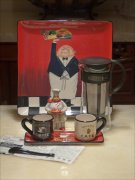The technique of making coffee is to make single-serve coffee with siphon pot
The siphon pot should be washed and ready for use, and its appearance should be dried to prevent it from bursting in case of fire. Pour 2 portions of hot water into the ball and heat it with an alcohol lamp. Put the filter in the upper half of the container, pull the small spring under the filter to hook to the bottom of the container, and the filter is glued to the bottom entrance to prevent the coffee powder from falling. Take two tablespoons of single powder (such as Colombian coffee or Brazilian coffee) with a spoon of about 10 grams each. If the amount of water is three people, take three tablespoons, pour into the bottom of the top half of the container from the middle, and try not to sprinkle the powder on the rest of the inner wall of the container. Insert the upper half of the container obliquely into the lower sphere, and then insert completely when the water in the sphere begins to bubble. The water gradually boils, and the boiling water in the lower sphere is sucked into the upper body by the siphon principle, but because the intubation of the upper body container is thick enough, the water will not be completely emptied, but a part of it will be left to tumble underneath, and the clock will start for 45 seconds. at the same time, use a wooden stirring stick to gently stir the coffee liquid in the same direction 2-3 times, do not touch the bottom filter. When the time is up, move the flame to the side of the ball bottom about 1 stroke 3 position, then time 15 seconds, the coffee liquid begins to flow down, the time is up to extinguish the alcohol lamp. The coffee liquid is left completely back in the sphere. Take a cup to drink and taste the unique flavor of single bean.
To make a single product, you can also use a pressure pot, the method is very simple, put the roasted coffee into the pot, add hot water to stir, soak for 4-5 minutes, press the stainless steel piston with mesh, coffee powder and liquid separation, you can pour out the juice to drink. It is said that this method can fully retain the original taste of coffee.
Important Notice :
前街咖啡 FrontStreet Coffee has moved to new addredd:
FrontStreet Coffee Address: 315,Donghua East Road,GuangZhou
Tel:020 38364473
- Prev

The technique of making coffee uses mocha pots to make cappuccinos.
Pour hot water into the lower container of the mocha pot, the water level is below the pressure hole, put into the filter rack, scoop into the mixing powder to the flat mouth, no need to press. Screw on the upper part of the container and be careful not to burn it. Heat it over the alcohol lamp, and when the water boils through the coffee powder, the coffee liquid will slowly overflow from the catheter in the upper half of the container, waiting for the sound of po-po- air in the pot, or open the lid to observe the catheter.
- Next

Fine coffee learn the difference between ice-brewed coffee and hot coffee with ice
There is an essential difference between ● ice drop coffee and iced coffee. Ice drop (or ice brew) coffee and ice or ice coffee seem to be a word of difference, but the two are essentially different in extraction and should not be confused. Ice drop (also known as ice brew) coffee is a coffee beverage extracted by soaking in water below 5 degrees Celsius for a long time at a low temperature. Iced coffee or iced coffee refers to quick extraction with hot water
Related
- Beginners will see the "Coffee pull flower" guide!
- What is the difference between ice blog purified milk and ordinary milk coffee?
- Why is the Philippines the largest producer of crops in Liberia?
- For coffee extraction, should the fine powder be retained?
- How does extracted espresso fill pressed powder? How much strength does it take to press the powder?
- How to make jasmine cold extract coffee? Is the jasmine + latte good?
- Will this little toy really make the coffee taste better? How does Lily Drip affect coffee extraction?
- Will the action of slapping the filter cup also affect coffee extraction?
- What's the difference between powder-to-water ratio and powder-to-liquid ratio?
- What is the Ethiopian local species? What does it have to do with Heirloom native species?

